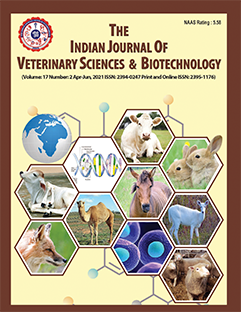Leptospira induced haemoglobinuric nephrosis in an adult horse and it’s therapeutic management- An uncommon incidence
DOI:
https://doi.org/10.48165/ijvsbt.21.5.35Keywords:
Leptospirosis, zoonosis, spirochete, livestockAbstract
Leptospirosis is a zoonosis caused by the spirochete, Leptospira interrogans, affecting various livestock species, including horses. Animals can act as carriers or reservoirs, transmitting the bacteria through urine to humans and thus has a great impact on public health. Worldwide, every year, approximately 1.03 million clinical cases are being reported in humans, leading to 58,900 deaths. Clinical form of leptospirosis in horses is uncommon or rare (Malanova, 2019) and infrequently reported owing to subclinical form of the disease and diagnostic challenges (Verma et al., 2013). The most common manifestation in affected horse is equine recurrent uveitis (ERU) (Gerding and Gilger, 2016), though the disease can cause vasculitis affecting kidneys, liver, central nervous system and genital tract (Divers et al., 2019). Horses acquire leptospirosis through feed or water contaminated with infectious urine and reproductive fluids (Verma et al., 2013) or through the skin. This paper reports an unusual case of equine leptospirosis with haemoglobinuria, it’s diagnosis by microscopic agglutination test and successful therapeutic management.
Downloads
References
Adler, B., & Moctezuma, A. D. P. (2010). Leptospira and leptospirosis. Veterinary Microbiology, 140, 287–296.
Díaz, E. A., Arroyo, G., Saenz, C., Mena, L., & Barragan, V. (2023). Leptospirosis in horses: Sentinels for a neglected zoonosis? A systematic review. Veterinary World, 16(10), 2110–2119.
Divers, T. J., Chang, Y. F., Irby, N. L., Smith, J. L., & Carter, C. N. (2019). Leptospirosis: An important infectious disease in North American horses. Equine Veterinary Journal, 51, 287–292.
Farias, D. K., Dick, G., Bunn, S., Neto, A. T., Rech, C., Menin, A., & Saito, M. E. (2020). Risk factors related to seropositivity for Leptospira spp. in horses in the Serra Catarinense region. Ciencia Rural, Santa Maria, 50(7), e20190483.
Gerding, J. C., & Gilger, B. C. (2016). Prognosis and impact of equine recurrent uveitis. Equine Veterinary Journal, 48, 290–298.
Malalana, F. (2019). Leptospirosis in horses: A European perspective. Equine Veterinary Journal, 51(3), 285–286.
Oscar, T. S., Juan, P. R., Antonio, H. B., Jorge, T. B., & German, L. G. (2021). Frequency of Leptospira spp. serovars reported in horses: A literature review. Abanico Veterinario, 11, 1–16.
Paul, B. R., Sharma, D. K., Raguvaran, R., Singh, S., Gandhar, J. S., & De, U. K. (2019). Therapeutic management of classic icteric leptospirosis in an adult horse - A case report. Indian Journal of Veterinary Medicine, 39(2), 45–47.
Ramsay, L., Eberhardt, C., & Schoster, A. (2024). Acute leptospirosis in horses: A retrospective study of 11 cases (2015–2023). Journal of Veterinary Internal Medicine, 38, 2729–2738.
Romanowski, T., Dias, R., Heinemann, M. B., Carvalho, S. F., Silva, T. A., Martins, A. S., Domingues da Cunha Caetano, G., Ferreira Junior, A., Santos, J. A., & Borsanelli, A. C. (2023). Seroprevalence of equine leptospirosis in the State of Goias, Brazil. Veterinary Sciences, 10, 590.
Sitprija, V. (2008). Altered fluid, electrolyte and mineral status in tropical disease, with an emphasis on malaria and leptospira. Nature Reviews Nephrology, 4, 91–101.
Sohail, M. L., Khan, M. S., Ijaz, M., Avais, M., Zahoor, M. Y., Naseer, O., & Saleem, M. U. (2017). Evidence of clinico-pathological changes during equine leptospirosis. Pakistan Journal of Zoology, 49(3), 849–853.
Verma, A., Stevenson, B., & Adler, B. (2013). Leptospirosis in horses. Veterinary Microbiology, 167, 61–66.
Downloads
Published
Issue
Section
License
Copyright (c) 2025 Indian Journal of Veterinary Sciences and Biotechnology

This work is licensed under a Creative Commons Attribution-NonCommercial-NoDerivatives 4.0 International License.




